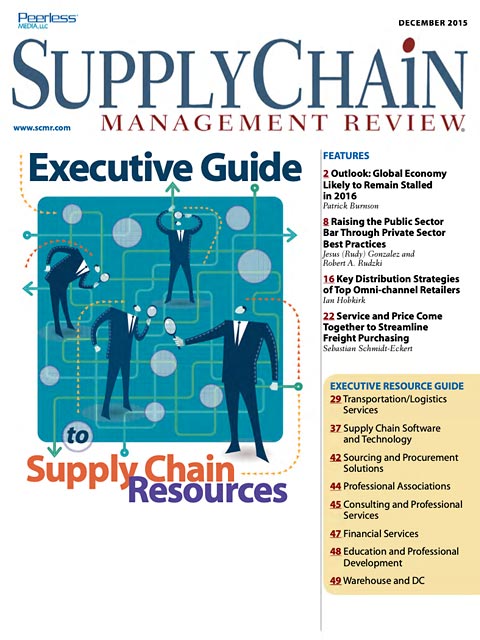Sorry, but your login has failed. Please recheck your login information and resubmit. If your subscription has expired, renew here.
December 2015
It’s December, and time once again for our annual Executive Guide to Supply Chain Resources. This is a comprehensive guide to services, products, and educational opportunities targeted specifically to supply chain professionals. The editors at Supply Chain Management Review wish all of our readers a successful year to come. Browse this issue archive.Need Help? Contact customer service 847-559-7581 More options
Lean practitioners are often skeptical of the ability of demand and supply chain planning to drive improved performance across the supply chain, preferring execution and lean levers. The reality is that planning is mathematical and abstract, and too often the results do not reflect reality. Lean execution, on the other hand, is experiential and the results are often directly visible.
Yet the real truth is more nuanced and the case for planning more compelling than most practitioners and executives are able to make a case for. It calls for real investments in process capability development, tools, and technology, and requires an organization to engage cross-functionally to tackle tradeoffs across the supply chain.
Even more fundamental is that many lean operational techniques depend on robust forward demand and supply chain plans to deliver results. Too frequently we see our clients drive the supply chain and inventory positioning based on run rate or backward-looking data. Without a robust plan, lean execution quickly falls prey to parts chasing, production and sequencing bottlenecks, and loss of efficiency. Lean execution does what it’s designed to do—react. However, lean execution needs additional help in environments characterized by higher mix, seasonality, or life cycle ramps, where the ability to execute must be correctly sized based on anticipated market level demand.
 |
This complete article is available to subscribers
only. Click on Log In Now at the top of this article for full access. Or, Start your PLUS+ subscription for instant access. |
SC
MR
Sorry, but your login has failed. Please recheck your login information and resubmit. If your subscription has expired, renew here.
December 2015
It’s December, and time once again for our annual Executive Guide to Supply Chain Resources. This is a comprehensive guide to services, products, and educational opportunities targeted specifically to supply chain… Browse this issue archive. Access your online digital edition. Download a PDF file of the December 2015 issue.
 |
Download Article PDF |
Lean practitioners are often skeptical of the ability of demand and supply chain planning to drive improved performance across the supply chain, preferring execution and lean levers. The reality is that planning is mathematical and abstract, and too often the results do not reflect reality. Lean execution, on the other hand, is experiential and the results are often directly visible.
Yet the real truth is more nuanced and the case for planning more compelling than most practitioners and executives are able to make a case for. It calls for real investments in process capability development, tools, and technology, and requires an organization to engage cross-functionally to tackle tradeoffs across the supply chain.
Even more fundamental is that many lean operational techniques depend on robust forward demand and supply chain plans to deliver results. Too frequently we see our clients drive the supply chain and inventory positioning based on run rate or backward-looking data. Without a robust plan, lean execution quickly falls prey to parts chasing, production and sequencing bottlenecks, and loss of efficiency. Lean execution does what it's designed to do—react. However, lean execution needs additional help in environments characterized by higher mix, seasonality, or life cycle ramps, where the ability to execute must be correctly sized based on anticipated market level demand.
 |
SUBSCRIBERS: Click here to download PDF of the full article. |
SC
MR

Latest Supply Chain News
- Tech investments bring revenue increases, survey finds
- Survey reveals strategies for addressing supply chain, logistics labor shortages
- Israel, Ukraine aid package to increase pressure on aerospace and defense supply chains
- How CPG brands can deliver on supplier diversity promises
- How S&OP provides the answer to in-demand products
- More News
Latest Resources

 Explore
Explore
Topics
Latest Supply Chain News
- Tech investments bring revenue increases, survey finds
- Survey reveals strategies for addressing supply chain, logistics labor shortages
- Israel, Ukraine aid package to increase pressure on aerospace and defense supply chains
- How CPG brands can deliver on supplier diversity promises
- How S&OP provides the answer to in-demand products
- AI, virtual reality is bringing experiential learning into the modern age
- More latest news
Latest Resources

Subscribe

Supply Chain Management Review delivers the best industry content.

Editors’ Picks





